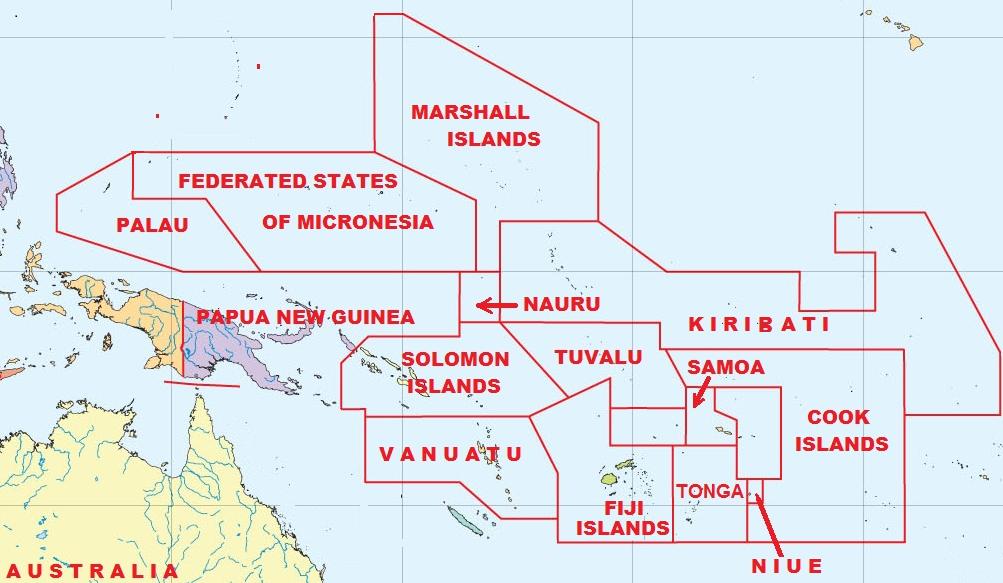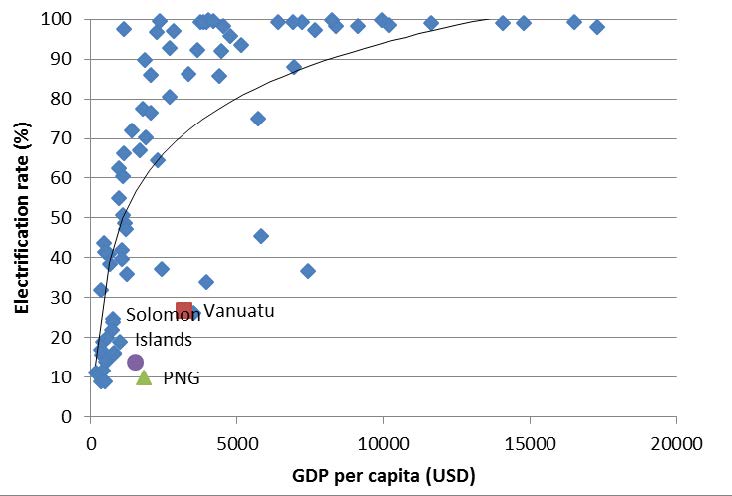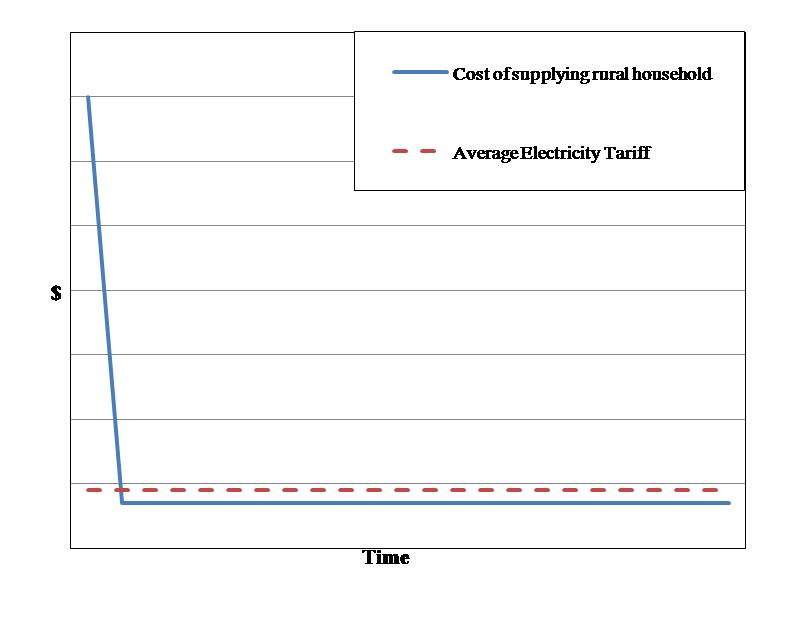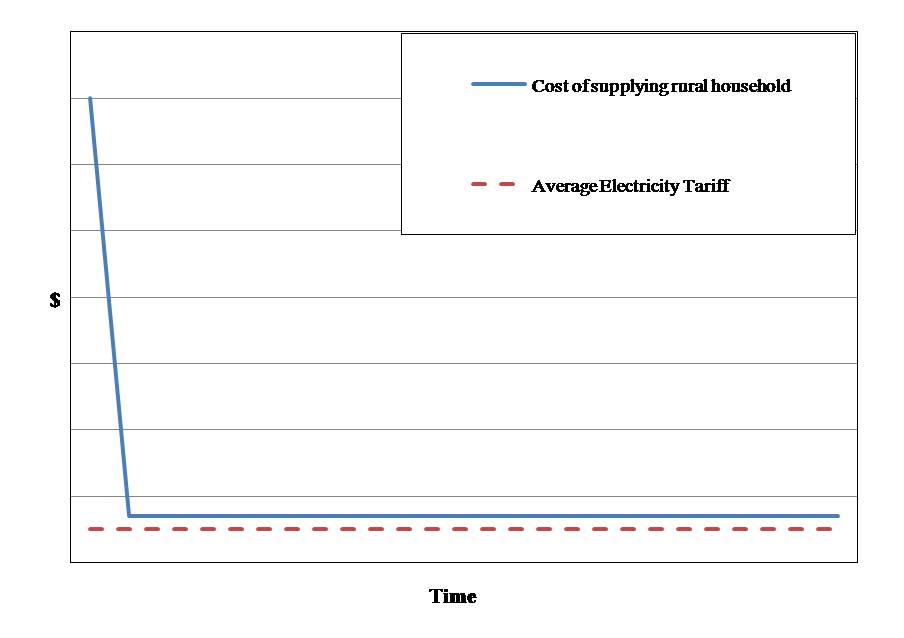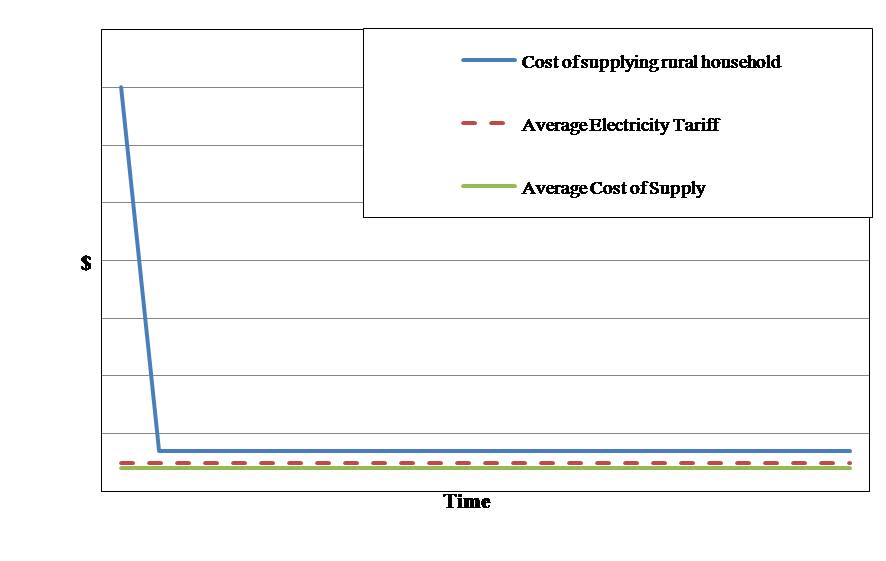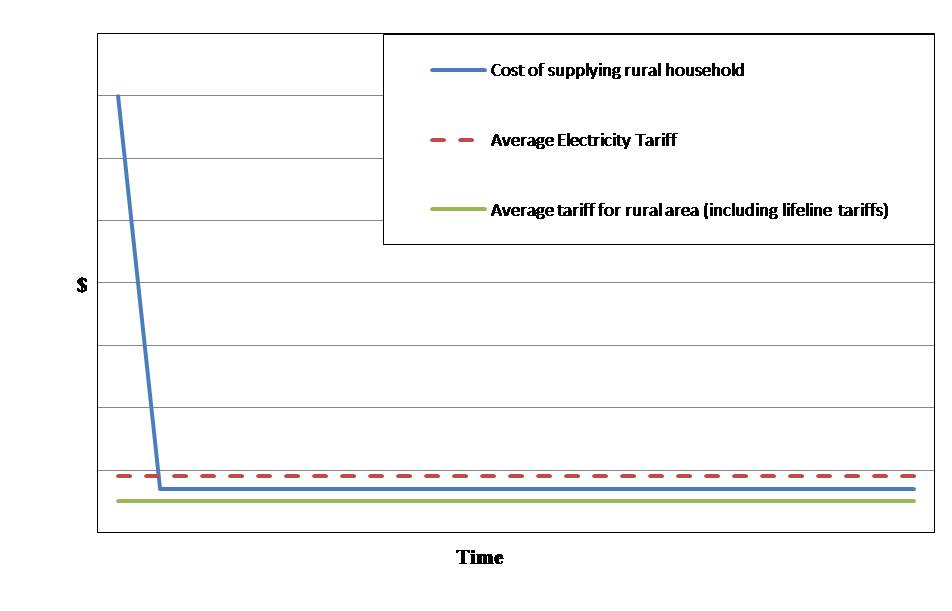1. Introduction
Small island developing states (SIDS) face unique constraints to the provision of electricity services, given their geographical features, and the small scale of government bureaucracies and markets. In SIDS that are situated in the Pacific Ocean, these factors have resulted in some of the lowest electrification rates in the world. Rural areas in particular are underserved. Past efforts by government and aid organizations to expand electricity access in rural areas have achieved negligible success, given regulatory frameworks that do not encourage extension of electricity networks, and the absence of effective institutional frameworks for operation and maintenance of decentralized systems.
This paper explores electricity access in SIDS situated in the Pacific Ocean. It contends that the binding constraint to rural electrification in Pacific small island developing states is the failure of regulatory frameworks to establish a viable business model for investment. On this basis, it argues that regulatory reform is needed that creates commercial incentives for private and public sector power utilities to provide power in rural areas, both through extension of electricity networks and decentralized power provision. Regulatory reform could also address past problems with the operation and maintenance of decentralized systems.
2. Materials and Method
2.1. Method
This paper surveys both grey and academic literature relevant to electricity access in Pacific SIDS in order to understand why access rates are so low in the region and what can be done to address the problem. In doing so, it brings together various strands of literature. This includes previous national energy planning documents, data, and academic work on electricity access; project documentation, data, and academic literature focused on electrification in rural communities using decentralized systems; and studies of regulatory arrangements in the power sector. The paper synthesizes research from across a number of years and sources in order to advocate for regulatory changes that would widen access to electricity in Pacific SIDS. It also draws from experience in other parts of the world where rural electrification efforts have been more fruitful.
The paper is structured as follows. The remainder of section two presents the context for this study and introduces the relevant literature. In doing so, the section outlines economic and social impacts resulting from low rates of electricity access, and explores why access to electricity is limited in Pacific SIDS. Section three presents the results of the study and discusses their implications. This section also outlines the principle arguments of the paper: institutional arrangements in the electricity sector, which include regulatory frameworks, have acted as barriers to the establishment of viable business models for rural electrification. It proceeds to discuss possible reform priorities, arguing that what is needed are ambitious rural electrification strategies rather than the piecemeal and ad hoc approaches of the past.
2.2. Literature and context
2.2.1. The global context
Energy poverty, or the lack of access to modern energy services, is a significant global development challenge. The International Energy Agency estimates that 1.3 billion people around the world are without access to an electricity supply, while 2.6 billion are without clean cooking facilities. The vast majority of both groups are situated in Sub-Saharan Africa and developing Asia [1]. On a per capita basis, access to power is most limited in Sub-Saharan Africa and in the Pacific islands region [2].
Access to modern energy services matters for a range of reasons. Access to clean cooking technologies reduces the incidence of respiratory diseases and enables women and children to spend less time searching for fuelwood. The supply of electricity facilitates economic activity, enables cold storage of food and vaccinations, and contributes to the delivery of government services (including in the health and education sectors). Electricity is essential for operation of appliances like computers, televisions, radios, and mobile phones, with these appliances being important sources of information for rural households. The use of electricity for lighting extends working hours, makes public spaces safer, and permits children to do homework at night [3,4]. The World Bank has found that electricity access is associated with an increase in the years that children stay in school [4].
Access to electricity also has financial advantages. Electricity replaces expensive traditional fuels such as kerosene for lighting and use of batteries to power small appliances such as radios. Surveys in Sub-Saharan Africa have shown that households without electricity access typically spend $57 annually on fuel and lantern costs. This is more than households that do have electricity access. The financial benefits of electrification have been found to apply to both households connected to the grid and those connected to more costly off-grid systems [4,5,6,7,8].
Similar financial benefits are also observed in SIDS. In Fiji, a number of surveys have found that un-electrified households spend more on energy for lighting than electrified households [9,10,11]. A study of communities in northern Fiji conducted in 2009 established that un-electrified households spent more on energy than households that were connected to an off-grid system (both solar home systems and village diesel generators were surveyed in the report) [12]. These un-electrified households were also more vulnerable to increases in the price of fuel.
It is no surprise that energy poverty should be negatively correlated with achievement of various Millennium Development Indicators, including maternal mortality rates, proportion of the population living on less than $1 per day, primary school completion, and gender parity in tertiary education [13]. The Sustainable Energy for All Initiative, launched by UN Secretary General Ban Ki-Moon, similarly highlights the need to increase access to modern energy services for the Millennium Development Goals to be achieved.
2.2.2. Reasons for lack of access to electricity
Lack of access to modern energy services remains a rural problem, despite the growth of informal urban settlements around the world. Approximately 84 percent of people without modern energy services live in rural areas, the majority of which are not connected to a centralized electricity network. These households commonly rely on traditional lighting fuels such as kerosene and benzene for lighting. Households without electricity are often also without access to clean cooking facilities [1].
There are a number of reasons for these ‘off-grid’ areas not being connected to the electricity grid. The low population density of many rural areas means that the extension of electricity networks is often not profitable for power utilities [14]. The fact that many rural households have low incomes further decreases demand for electricity, which again, makes investment in grid extension non-commercially viable. Regulatory arrangements in the electricity sectors of many countries are also a factor. The majority of electricity utilities around the world are state-owned [15]. Many power utilities are not operated on a purely commercial basis, instead being required to provide electricity below cost, or to cross-subsidize communities where power is supplied on a non-commercial basis using profits from commercially viable areas. This has meant that power utilities are often on a poor financial footing, unable to invest in extension of electricity networks.
Decentralized electricity generation and supply has been used to meet some of the demand for electricity in off-grid rural areas [13]. The advantage of decentralized power provision is that its upfront cost is significantly lower than extension of the electricity grid. In Sub-Saharan Africa, for example, connection to the electricity grid in urban areas is estimated to cost approximately $153. By contrast, in areas where there is no electricity network, grid construction and connection costs can exceed $1149. Extending the grid to rural areas can be more costly still, depending on the distance involved [16].
A review of the rural electrification in Fiji found that the average cost per connection of grid extension was almost four times that of installing an off-grid diesel-fuelled generator [17]. However the upfront cost associated with installation of off-grid systems is still significant for cash-poor rural households. Many rural electrification initiatives as a result have sought to address this barrier to electricity access by providing credit or subsidizing/donating decentralized off-grid technologies to un-electrified rural households. The problem with such an approach is that it does not address other challenges related to maintenance and operation of off-grid power generation systems. The donation model, involving the donation (or heavy subsidy) of decentralized electrification systems, was once popular among development partners, and is still used. However, many such projects failed due to failure to improper operation and/or failure to maintain donated systems. The failure to ensure project sustainability has meant that donation of systems is now generally complemented by various forms of institutional support and training [18,19].
It has proven difficult to address maintenance challenges. Building the capacity of rural communities to maintain off-grid systems through training and establishment of institutional arrangements at the community-level for decision making has often borne only temporary results. Common challenges to community-based maintenance include the migration of technicians away from rural communities (often to find employment in urban areas using their new skills), and the failure of rural communities to set aside appropriate funds for periodic maintenance (such as battery replacement) [18,20,21]. Government provision of maintenance has also achieved mixed results, with the quality of government support in many cases compromised due to inadequate funding being provided to the responsible agency [21,22].
One criticism levied at rural electrification projects is that they have hindered the organic development of energy businesses through government or donor provision of off-grid systems below cost. This criticism is especially relevant in the case of renewable technology projects, which affect a nascent but less developed industry, are generally more heavily subsidized, and are more likely to involve the supply of generation equipment made overseas [23,24,25]. Partly as a response, development partners are increasingly focused on using the private sector for rural electrification [24,25,26]. Experience with rural electrification by commercial entities remains limited in SIDS of the Pacific [12,21].
3. Results and Discussion
3.1. Small island developing states: a special case
The Small Island Developing States (SIDS) of the Pacific, with the exception of Papua New Guinea, are among the smallest independent nation states in the world (see Table 1 and Figure 1). These states, which are often referred to collectively as the Pacific island countries, share many common characteristics, such as the continuing importance of traditional forms of governance, including communal land ownership; geographical features such as distance from major markets and exposure to natural disasters; poor and/or costly transportation services; and high levels of development assistance (with some exceptions). But there are also important differences among these countries. Some Pacific SIDS, such as Cook Islands, enjoy high per capita incomes owing to free migration with metropolitan countries (Cook Islanders enjoy New Zealand citizenship). These countries have very high levels of electrification. Other Pacific island countries, such as Papua New Guinea, suffer some of the worst development indicators in the Asia Pacific region [27]. The quality of government also differs across countries, with the public sector in Polynesian countries such as Samoa generally more effective than in clientelistic Melanesian countries such as Solomon Islands and Papua New Guinea [28,29].
Table 1. Pacific small island developing states: key statistics.
| Country | Population (last census) | GDP per capita (current USD) | Land size (km2) | Exclusive economic zone (km2) | Aid dependence (ODA/GNI, 2010-2012) |
| Cook Islands | 15,324 | 11813 | 240 | 1,800,000 | n.a |
| Fiji | 837,271 | 4397 | 18,272 | 1,260,000 | 2.4% |
| Kiribati | 92,533 | 1648 | 726 | 3,600,000 | 20.9% |
| Nauru | 9233 | 7329 | 21 | 320,000 | n.a |
| Niue | 1625 | 5800 | 259 | 390,000 | n.a |
| Palau | 19,907 | 8031 | 487 | 600,900 | 12.1% |
| Papua New Guinea | 7,059,653 | 1844 | 462,000 | 3,100,000 | 5% |
| Marshall Islands (Republic of the) | 50,840 | 3168 | 181 | 2,100,000 | 39.9% |
| Micronesia (Federated States of) | 102,624 | 2781 | 700 | 2,900,000 | 38.5% |
| Samoa | 180,741 | 3485 | 2934 | 120,000 | 20.6% |
| Solomon Islands | 515,870 | 1517 | 28,000 | 1,600,000 | 48.3% |
| Tonga | 101,991 | 4151 | 688 | 700,000 | 18.8% |
| Tuvalu | 9561 | 3636 | 26 | 757,000 | 48.3% |
| Vanuatu | 234,023 | 3094 | 12,190 | 680,000 | 13.8% |
| Source: Asian Development Bank (ADB), World Bank, Secretariat of the Pacific Community (SPC) Pacific Island Populations-estimates and projections of demographic indicators for selected years. http://www.spc.int/sdp/. ODA (Official Development Assistance)/GNI (Gross National Income calculated using ODA data taken from OECD Development Assistance Committee Creditor Reporting System database (http://stats.oecd.org/) and World Bank data on GNI (http://data.worldbank.org). n.a = data not available. |
The rate of access to electricity in SIDS of the Pacific is low by international standards, being equivalent to access rates in sub-Saharan Africa and slightly below the average for low income countries. There is nonetheless considerable variation in the electrification rates of different Pacific SIDS. Access to electricity is widespread in countries with high income levels such as Palau, Cook Islands, and Fiji.1 (1 There is a statistically significant relationship between log GDP per capita and access to electricity.) In a number of micro-states all households have access to electricity, such as in Nauru, a single island state with a population of below 10, 000. Energy poverty in the region is concentrated in three countries: Papua New Guinea, Solomon Islands and Vanuatu. These countries account for 84 percent of the population of all 14 independent SIDS in the Pacific, and have very low levels of access to electricity, lower than in other countries with similar GDP per capita (see Figure 2).
There are a number of explanations for low levels of electrification in Papua New Guinea, Solomon Islands and Vanuatu. These countries remain rural societies, with the bulk of people residing in rural areas that are distant from the (small) electricity networks that mainly serve urban areas. Widening access to electricity in these countries is therefore primarily about rural electrification. However, connecting rural households to an electricity grid is generally not financially feasible, given low levels of demand, low population density, and geographical constraints (all three countries comprise archipelagos of islands) [21,41]. Other infrastructure is not developed in rural areas, meaning both that (i) extension of electricity networks is more costly, due to the need to extend roads into rural areas, and (ii) electricity is generally a lower priority for rural households than other infrastructure development [12].
Decentralized, off-grid electrification is more feasible, but it still involves significant upfront costs for households. These upfront costs are often beyond the capacity of rural households to fund [4]. Rural households are often reliant on subsistence agriculture for livelihoods, with cash income very limited. The availability of credit is also poor. Land is the only asset of significant monetary value owned by most rural Pacific islanders, but ownership is vested in communal structures which prohibit its use as collateral [28]. The absence of transport links means that maintenance of off-grid electrification systems is made more costly and challenging; it is difficult to get parts, and there are generally no technicians or companies that travel to rural areas to repair failed off-grid power systems. The market infrastructure and technical capacity for management of off-grid and mini-grid technologies is therefore missing in rural areas of the Pacific SIDS [12,41].
3.2. The need for a viable business model
There are many constraints to widening access to electricity in Pacific SIDS. However, one issue stands out as a binding constraint: the absence of a viable business model. Power utilities in Pacific SIDS have neither commercial nor regulatory incentives to extend electricity networks, nor do they have a mandate (or incentive) to provide electricity using decentralized systems [21,42,43]. This is reflected in the fact that rural electrification projects in the region involving off-grid or mini-grid systems have typically been implemented by government ministries (public works departments or departments of energy) rather than by power utilities. The bulk of funding for such projects has been provided by development partners [21,44].
What is required to establish a viable business case for rural electrification in Pacific SIDS? The high upfront costs associated with rural electrification mean that a subsidy is generally required—whether for extension of the electricity network or for the installation of decentralized, off-grid systems. Subsidies can take many forms, and can be provided by governments or development partners. The most common form of subsidy used in Pacific SIDS is a cost sharing arrangement, where governments (or development partners) pay a proportion of the cost of grid extension or installation of a an off-grid system [41]. The common practice of cross-subsidisation means that households that already have electricity access also contribute, indirectly, through higher electricity prices.
Subsidies for rural electrification can be significant. In the case of Fiji, the government pays 95 percent of the cost of rural electrification and households pay the remaining 5 percent. This payment is not means tested, meaning that high-income households also benefit from the subsidy. However, the generosity of such subsidies also means that they are in high demand. In Fiji as well as many other Pacific SIDS, there are long waiting lists for rural electrification subsidies, given the provision of inadequate funding for subsidies by government [12,21].
However, more than just one-off subsidization is needed for rural electrification to be a viable business prospect. The provision of a one-off subsidy to address the high upfront cost of electrification is only effective where, upon electrification, the power utility can generate a profit from the new connection. For this to happen, the electricity tariff paid by newly connected households must be higher than the ongoing cost of supply (less any government subsidy for connection or installation). This condition is illustrated in the hypothetical scenario presented in Figure 3.
Existing regulatory structures in Pacific SIDS mean that this basic condition is often not achieved. A recent benchmarking survey of Pacific power utilities suggests that there are six utilities that make a loss on every unit of power that they sell [43].2 (2 This data are supplemented by statistics provided in the National Infrastructure Investment Plans of five Pacific island countries (available at www.theprif.org )) Electricity tariffs in these cases are artificially low, as shown in Figure 4. This is often as a result of political imperatives: political leaders responsible for approving increases in tariff prices have clear political incentives not to do so. The result is that utilities have no commercial incentive to extend the electricity grid [19]. Electrification only occurs in these cases where utilities are obliged to extend the grid (through regulatory mechanisms, or more often, political pressure). Ongoing operating subsidies must also be provided by governments to ensure the sustainability of electricity access.
Pacific power utilities receive various types of government subsidies. These commonly take the form of ad hoc payments used to support power utilities in financial distress, or government assistance with major expenditure (such as periodic maintenance of distribution network). However power utilities in the Pacific are rarely obliged to extend the grid to new areas in order to access these subsidies. A survey of power utilities reported that only two Pacific utilities had in place a service obligation to rural areas near the grid [43]. Electricity sector legislation instead requires utilities to serve paying customers already connected to the grid, meaning that operating subsidies are directed towards existing customers. These subsidies have a fiscal cost; the provision of ongoing financial support to a power utility means that there are fewer resources available for new connections to the grid, or for rural electrification using off-grid technologies.
Regulatory arrangements in the electricity sector affect electrification in other ways. Electricity utilities around the world often charge a uniform tariff for power, despite the fact that the cost of supply varies between different areas. This is also the case for the majority of power utilities in the Pacific. Urban centers where demand for power is highly concentrated are generally profitable for the utility, and are used to cross-subsidize loss-making rural areas where demand is less concentrated and transmission and distribution losses are higher [15,19]. The practice of cross-subsidization is motivated by equity objectives, and is often legislated. It is also easier to administer for the power utility.
The potential impact of cross-subsidization on rural electrification is illustrated in Figure 5. Although electricity tariffs may be higher than the average cost of supply, and a power utility may be profitable, the cost for the utility of supplying a rural household may exceed the uniform tariff rate. The result is that the utility has no commercial incentive to provide electricity in rural areas, unless it is subsidized for ongoing supply of electricity to non-profitable areas. Many Pacific power utilities have been or are in this situation. In Fiji for example, operations in Suva, the capital city, were used to fund electricity provision to the rest of Fiji for many years, as part of an informal community service obligation [45]. Lifeline tariffs, which are designed to make electricity affordable for low income households by charging less for low levels of usage, can worsen this situation, given the high incidence of low income households in rural areas. In Figure 6,this undermines the commercial viability of electricity provision in rural areas, even where the average electricity tariff (not including lifeline tariffs) is higher than the cost of supplying rural areas with power.
Much of the discussion so far has focused on existing power utilities, which generally supply power through an electricity network (with some exceptions). Also important is the ability of new power providers to supply electricity in un-electrified rural areas, whether through construction of new electricity networks, installation of mini-grid or off-grid systems, or through extension of electricity grids managed by existing utilities. Current regulatory arrangements are also a barrier to new entrants. In most Pacific SIDS, legislation provides existing power utilities with a monopoly over electricity provision. The majority of utilities are state-owned. Legislation establishing a monopoly over electricity provision limits the ability of firms to establish new power networks in rural areas. It is also a barrier to the establishment of energy service company (ESCO) models that have successfully provided electricity using decentralized, stand-alone systems in Sub-Saharan Africa and Latin America [for a discussion, see 21].
Recent reforms to facilitate the entry of independent power producers in various SIDS, including Fiji and Tonga, have not adequately addressed this issue [46]. These reforms are aimed at facilitating investment in renewable power generation for the existing electricity network. They are not aimed at extending electricity access. The establishment of very ambitious renewable energy targets has been criticized as a result, notwithstanding the economic merits of such investments for SIDS [44]. Dornan [47] for example argues that the use of aid to fund such investments is not always appropriate, as the focus of targets on the quantity of electricity produced tends to favor investment in existing grid-connected electricity generation. The result is that funding is skewed towards urban areas, which tend to have higher incomes than rural areas.
Changes to legislation that establish monopolies over power supply are needed to facilitate rural electrification. However, alone this is unlikely to be sufficient to encourage new entrants. Other regulatory changes are also required. Electricity pricing must reflect the cost of supplying power to rural areas. The uniform national tariffs currently employed in most countries - and their application to mini-grid systems - are a barrier to new entrants investing in rural power supply. There is simply no business case for extension of such electricity networks, or for the establishment of new networks or mini-grid systems, under such pricing arrangements.
3.3. Regulatory reform and rural electrification strategies
Reform is required across a number of areas for rural electrification to be commercially viable. For pricing to reflect the true cost of power supply to different areas, a robust institutional framework for establishing electricity prices is needed. Power prices set by political leaders have been shown to be below the true cost of supply in Pacific SIDS, with adverse implications for the financial health of power utilities and the quality of electricity supplied. Independent regulation is therefore needed. A number of Pacific SIDS have now established independent bodies that set power prices. The results are encouraging, with better financial and technical performance by power utilities in countries where prices are set by an independent regulatory board or agency. In most cases, low income households have been protected from higher electricity prices through the use of lifeline tariffs for consumption of small quantities of power [21,46].
The establishment of independent regulatory bodies can also facilitate access to electricity through the creation of electricity concession areas. This approach has been successful in other parts of the world. The concept of a concession is a simple one. An electricity concession is awarded to a company for the delivery of electricity to a pre-determined area. Companies compete for the concession, which is awarded by government on the basis of selection criteria. In return for supplying electricity, the concessionaire is given a monopoly over the supply of electricity to the area for a period of time, with customers obliged to pay a regulated fee for the electricity that they consume. The advantage of a concession approach is that it generates competition through the tender process, while at the same time achieving economics of scale by ensuring that there is a “critical mass” of customers in one area (this critical mass might disappear if there was more than one supplier, thereby raising the subsidy required by private companies for supply) [24].
The design of a concession agreement is very important. Concessionaires - whether private business or state-owned commercial entities - are motivated by commercial considerations and do not have the same incentives as governments. This is evident where concessionaires have extended the grid to areas that are more likely to generate profit, rather than prioritizing areas on the basis of social needs [48]. It is therefore necessary to provide concessionaires with appropriate incentives. Such incentives can be established through the use of output-based subsidies, where concessionaires are awarded for electrification of rural households (including low income households) [49,50,51].
One of the first regions to pursue rural electrification using output-based subsidies was Latin America. In Argentina, the government developed concessions in the 1990s to encourage rural electrification in the north-west of the country. The Renewable Energy in the Rural Electricity Market Project (Proyecto de Energía Renovable en el Mercado Eléctrico Rural, or PERMER) was designed by the Argentine Government with support from the World Bank in order to target households that were distant from the grid. Concessions were awarded for 15 years as part of the project, obliging the concessionaire to provide all eligible households within a certain area with an off-grid electricity supply. Households were required to pay a portion of the upfront cost of connection (at least 10 percent) to be eligible for the program. Electricity was sold to households on a commercial basis.
The concessions approach in Argentina is widely regarded as a success. Between 2001 and 2011, the approach led to the electrification of 11, 500 households and 1600 public buildings. The ten private companies with concessions were provided with incentives to extend access to electricity through the provision of subsidies. Subsidies were funded by a World Bank loan, a Global Environment Facility grant, and the Argentine Government, while electricity prices and connection fees were regulated by provincial authorities and reviewed every two years.
Another country that has successfully used output-based subsidies for rural electrification is Chile. Starting in 1994, the Chilean Government awarded one-off subsidies through a competitive process to private sector companies for the supply of power to un-electrified households. Grid extension was the main focus of the scheme, although off-grid systems were installed in remote areas. Operators were obliged to provide a minimum percentage of total funding, with some providing more than required in order to maximize their chance of winning the subsidies. Households contributed approximately 10 percent of the upfront cost of electrification.
The output-based subsidy program for rural electrification in Chile is considered a resounding success. Access to electricity in rural areas increased rapidly as a result of the program, from approximately 50 percent in the early 1990s to over 96 percent in 2006. Government subsidies were intended to cover 75-80 percent of the cost of connection [19]. However private sector funding towards rural electrification was higher than first anticipated. Between 1994 and 1999, the government paid subsidies worth US$112m (65% of cost) while private operators invested US$60m (35% of total costs as opposed to the originally anticipated 20%-25%) [49].
Government subsidies in Chile were granted on the basis of multiple criteria, including cost-benefit analysis, commitment to invest, and social impact. The cost-benefit focus was designed to ensure that subsidies were required only for initial connection costs. Companies were required to show that after connection, they could make a profit and would have incentives to ensure the continuing supply of high-quality electricity. The inclusion of social impact in the selection criteria encouraged private companies to work closely with community groups when preparing bids, and ensured that low income households were included in project design.
The use of similar approaches for rural electrification has been limited in the Pacific islands. One market-based approach that has been used for off-grid rural electrification in several Pacific Island countries is a user-pays arrangement where an Energy Service Company (ESCO) provides ongoing technical support to households. An ESCO model was used to install solar-based off-grid systems in Kiribati and Fiji. Both initiatives have faced problems given poor design [for a discussion, see 12, 21]. However the concept of utility-based operation and maintenance of off-grid systems continues to have merit in a region where electricity access in rural areas is very limited, and where government and community operation of off-grid systems has largely failed.
More recently, concession-based approaches to rural electrification have also been explored by the Vanuatu Government, which is considering establishing new concession areas in which firms will supply power, using mini-grid and off-grid systems, in return for being granted a monopoly over power supply for a set period. Initial indications suggest that this approach shares much in common with the schemes used to extend electricity access in Chile and Argentina, although details are yet to be finalized. Vanuatu enjoys a number of advantages in utilizing such an approach, given that it: (i)has an established utility regulator, (ii) has more experience with price and service regulation than most other Pacific SIDS, and (iii) the private sector is already involved in the supply of electricity to numerous concessions (although these are in urban areas). Vanuatu is a small country: if it can establish an effective regulator, with external support, then other SIDS of a similar size should be able to do the same.
The approach proposed in Vanuatu and outlined above is different to what has been used in the past in Pacific SIDS. Rural electrification in the Pacific has generally been funded by development assistance, or sometimes, by Pacific island governments. The installation of off-grid systems or mini-grid systems has often not been accompanied by institutional developments that adequately support the operation and maintenance of these systems. Many have failed as a result. Where existing electricity networks have been extended, this has generally been funded by government. Power utilities are obliged to supply power to newly connected households, although many lack the commercial incentives to do so. Few utilities have therefore invested in grid extension on commercial grounds.
Rural electrification motivated by commercial considerations is therefore extremely uncommon in Pacific SIDS. Given fiscal constraints, this has meant that access to electricity in Pacific SIDS has expanded slowly. Indeed, at current population growth rates and expansion of access to electricity, the proportion of Pacific islanders without access to power is set to increase in future years (although urbanization should have the opposite impact, provided rural-urban migrants are supplied with electricity in urban areas). New approaches are required that leverage government subsidies with funding and expertise from the private sector, and from publicly-owned but commercially-oriented power utilities. This need not mean re-inventing the wheel. Other regions have shown that electricity access can be expanded rapidly under the right institutional settings. As discussed, the proposed establishment of new concessions in Vanuatu draws heavily on the approach taken in Chile and Argentina in the 1990s and 2000s. Sub-Saharan African countries such as Zambia have shown the potential for energy service companies to expand electricity access using off-grid systems. But mimicking these experiences will require institutional change and regulatory reform.
4. Conclusion
This paper has explored access to electricity in small island developing states (SIDS) situated in the Pacific Ocean. It has surveyed both grey and academic literature relevant to electricity access in Pacific SIDS, bringing together various bodies of literature such as national energy planning documentation; project documentation, data, and academic literature focused on electrification in rural communities using decentralized systems; and studies of regulatory arrangements in the power sector. It has also drawn from experience in other parts of the world where rural electrification efforts have been more fruitful.
Electricity access in Pacific SIDS is low by international standards, and on the basis of what would be expected given per capita incomes. Geography no doubt is partly responsible, given the distribution of small populations in rural areas across island archipelagos. However, institutional factors are also important. This paper has argued that the binding constraint to rural electrification in Pacific small island developing states is the failure of regulatory frameworks to establish a viable business model for investment. Power utilities operating in Pacific SIDS have no incentive to supply rural households with electricity, given the use of uniform electricity tariffs that are often set below cost. The same regulatory structures have limited the entry of new power suppliers, and have hindered investment in decentralized off-grid systems. The expansion of electricity access in the region has been slow as a result, with rural electrification initiatives driven only by government and development funds.
New approaches are needed to expand electricity access in Pacific SIDS. There is extensive experience in other regions that can be drawn on in designing rural electrification strategies. Given the very limited resources available to governments, approaches should be pursued that leverage funding and expertise from the private sector and from publicly-owned but commercially-oriented power utilities private sector. Experimentation with renewable energy service company models has occurred in Pacific SIDS, but only on a fairly small scale, and generally involving small companies that do not have the capacity to meet the large rural electrification challenges faced by these countries. Such approaches, which have typically involved ad hoc projects, are not adequate. More ambitious institutional and regulatory reform is required: reform that change the way in which prices are set and the incentive structures of power utilities. Some Pacific SIDS are taking steps in the right direction. Regulatory reform is being implemented in a number of countries, and proposals for the establishment of new concession areas are being considered by the Government of Vanuatu. But further changes are required if Pacific SIDS hope to replicate the rapid expansion of electricity access enjoyed in countries such as India, Indonesia, and in regions such as Latin America.
Conflict of Interest
The author declares no conflicts of interest in this paper.









 DownLoad:
DownLoad: 